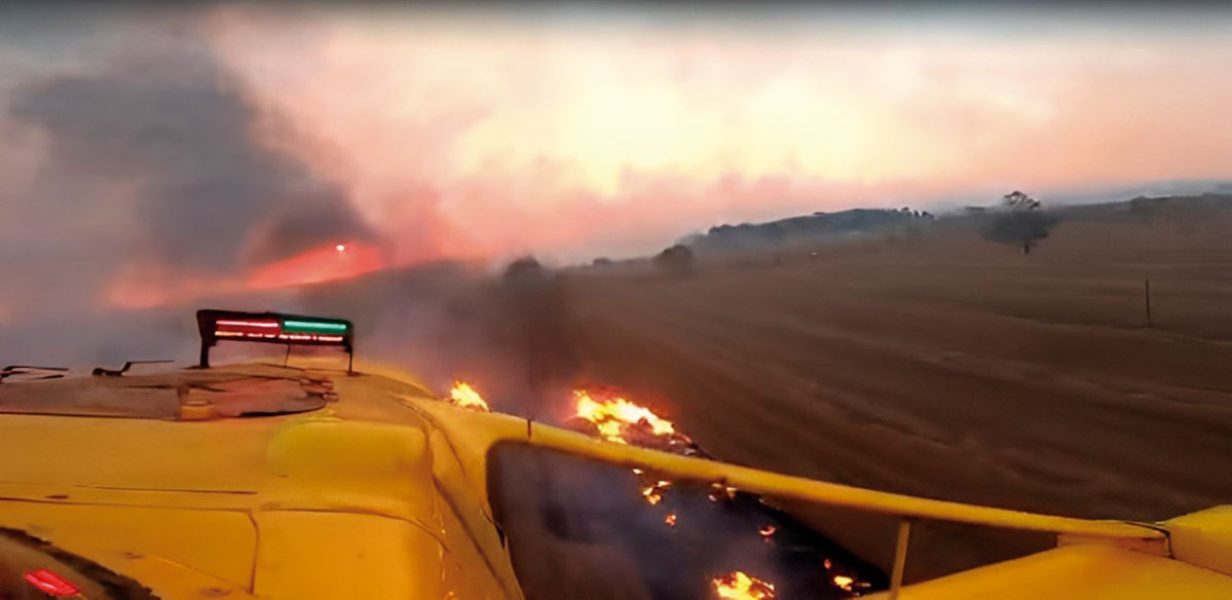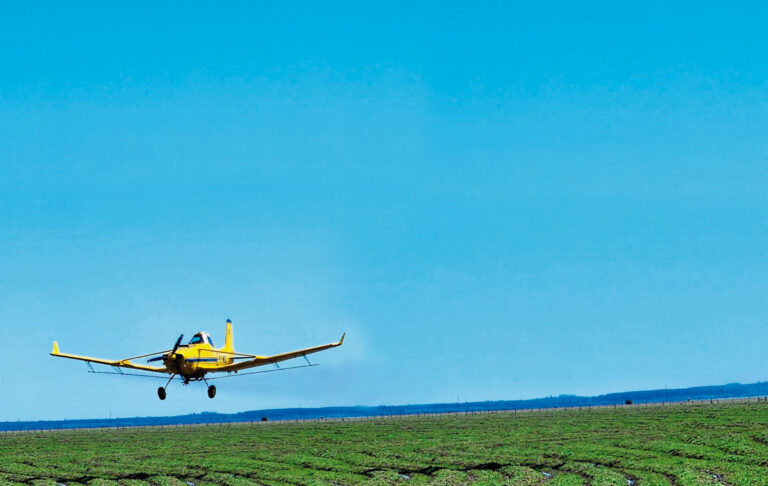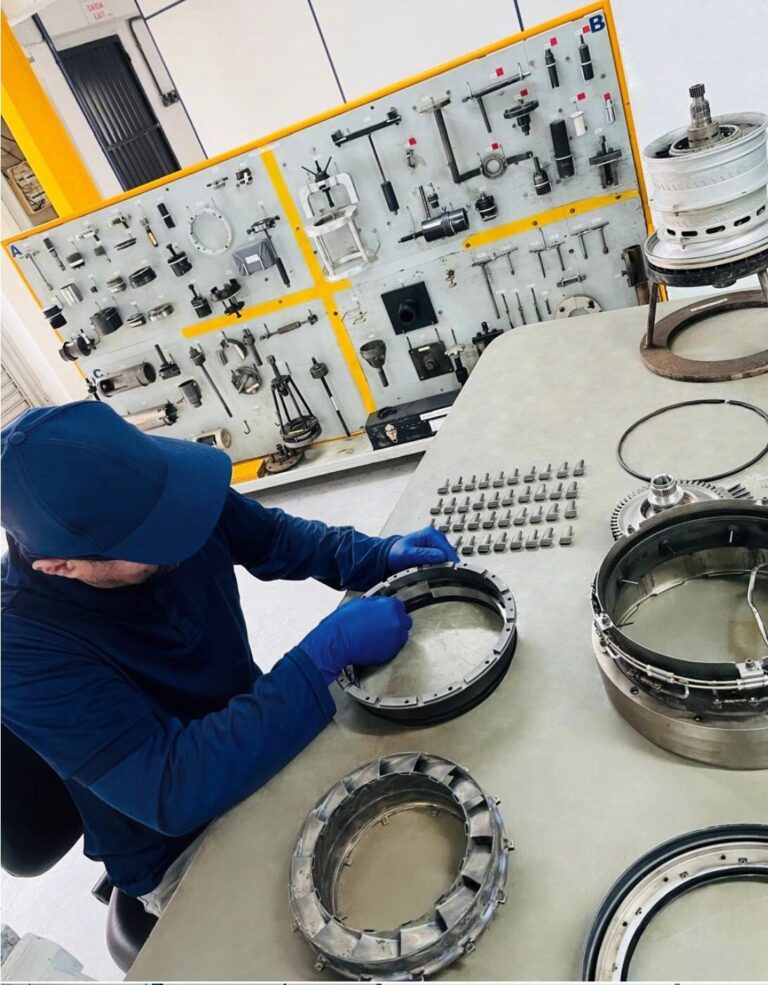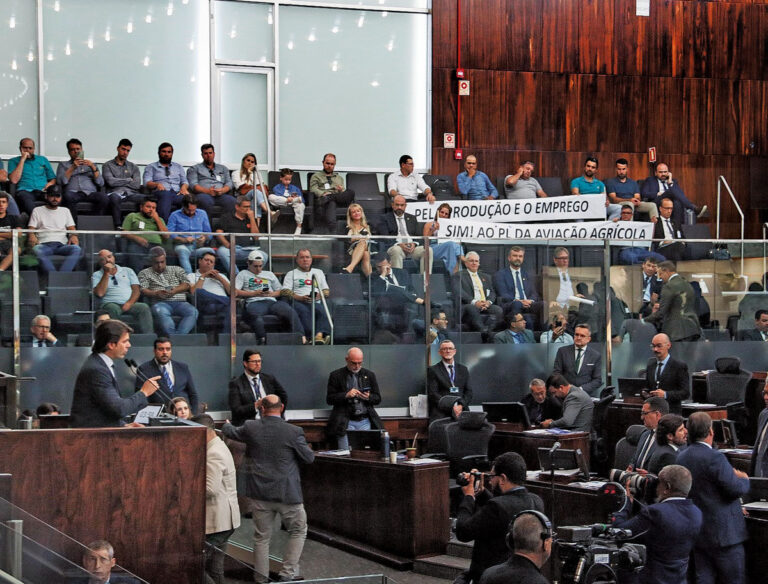Brazilian agricultural aviation used no less than 40.1 million liters of water to fight fires in 2024, in aerial firefighting operations in 11 Brazilian states between July and October. The figures are part of a survey carried out by the National Union of Agricultural Aviation Companies (Sindag) on the operations of 22 aero-agricultural companies fighting fires this season. For this, data from a questionnaire distributed by Sindag to its members was taken into account, as well as information gathered from the Chico Mendes Institute for Biodiversity Conservation (ICMBio) and environmental and Civil Defense agencies in the states that hired the companies for operations against the flames.
According to Sindag’s report, aerial operations against the flames involved 118 planes, which logged 10,700 flight hours protecting biomes and farms, in support of firefighters on the ground. To this end, more than 16,600 maneuvers were carried out to launch water (pure or with flame retardant), by 171 pilots (who took turns operating the aircraft) and with 140 professionals providing support at the operational bases – supplying the aircraft with water and fuel and other operational tasks.
The figures are much higher than those for operations in 2021, the year in which Sindag had its last firefighting balance sheet. At the time, operations across the country had added up to 10,900 water releases, with a total of 19.5 million liters in 4,000 hours of firefighting flights.
INDICATORS
The scenario of fires registered by the National Institute for Aerospace Research (INPE) also confirms this growth. According to the agency’s Wildfires Program, 2021 had 5,469 outbreaks of fire across the country. With 2024 already totaling 8,674 outbreaks. This is while the two middle years (2022 and 2023) recorded 1599 and 1666 fires respectively across the country. To top it all off, the month of August recorded 3,612 fires in the country. This was the highest rate among all the months recorded in Inpe’s historical series since 1998.
The intensity of the year had already been signaled in the preliminary survey carried out by Sindag at the end of August, which indicated that 15.8 million liters of water had been used against fires in the Pantanal (MT and MS), São Paulo and Goiás. The operations had already involved aircraft working for official bodies and rural producers. Of that total, most of the operations had been against fires in the Pantanal (in MT and MS). In this case, in support of the more than 200 firefighters and firemen fighting the fires on the ground.
At the time, work was already intense for the fire brigades set up by the aero-agricultural companies that serve rural producers in Goiás every year. The farmers and mills themselves have already learned that the use of aviation makes it more efficient to support personnel on the ground when the call for help is made as soon as the outbreak is detected.
Furthermore, for the first time, the state of Rondônia decided to hire an aerial company to maintain an aerial firefighting brigade. There were 47 days of operations, with two aircraft totaling around 4 million liters launched against the flames in the state. The company worked in conjunction with the state (firefighters) and federal (ICMBio) governments, keeping two aircraft on call.
Coordinated operations with ground personnel
In aerial firefighting operations, around 90% of the work is done in partnership with firefighters on the ground. With the team leader on the ground requesting air support and coordinating with the pilot how the launch is made. In large fires, the plane’s role is usually to reduce the fire so that the brigade members can reach the outbreaks safely.
This is because it is ground personnel who completely eliminate the flames and also do the “surgical work” against braziers – which, if not extinguished, can reignite the fire line. Agricultural aircraft operate alone when the outbreaks are in areas that are difficult to access, such as hillsides or rough terrain. When there is an urgent need to create an escape corridor for wildlife surrounded by flames or when there is no team nearby and it is necessary to hold or try to eliminate the fire line with more water releases.
PREROGATIVE
This model of operation with planes and firefighters has been adopted internationally. For more than three decades, it has been used in Brazilian nature reserves and, later, it was also used in crops (together with brigade members from farms and mills). Agricultural aviation has been operating in federal reserves in partnership with ICMBio teams since the agency was created in 2007.
Before that, it had been operating since the 1990s with teams from the Brazilian Institute for the Environment and Renewable Natural Resources (Ibama) and (in the states) with firefighters. In addition, since the 1960s, fighting fires in fields and forests has been one of the prerogatives of the agricultural sector. In 2022, the country passed a federal law including agricultural aircraft in government policies for fighting forest fires.

Rondônia state government has included agricultural aircraft in its policy to combat forest fires
Challenging operations in defense of biodiversity
“It’s challenging. Due to the proximity of the fire, the aircraft suffers from turbulence and the smoke makes visibility difficult. This increases the tension, because we normally fly in wings – that is, at least two aircraft. In addition, there are helicopters transporting firefighters and supporting operations. All this is happening at the same time.” This is the testimony of the chief pilot of Aeroterra Aviação Agrícola, Leandro Kemmerich, one of the many people who went to the front line to help extinguish the flames burning over various regions of Brazil.
The fire season usually takes place between July and November, but this year it started earlier. The first four Aeroterra aircraft were called in by the Chico Mendes Institute for Biodiversity Conservation (ICMBio), a federal agency linked to the Ministry of the Environment (MMA), in the second half of June, when the fire was already spreading in the Mato Grosso Pantanal.
Kemmerich says that the aircrafts are already prepared for firefighting right after the harvest. There are regions that historically suffer from fire. And, as a precaution, the agencies call the company to be on call in anticipation of fires. “There are cases where we arrive with a very challenging scenario, with a large fire,” says the pilot, who is 42 years old, has been flying agricultural aircraft for 18 years and has been fighting fires since 2015.
To give you an idea, Aeroterra, as well as serving the Pantanal, in the states of Mato Grosso do Sul and Mato Grosso, has also deployed aircraft to Chapada dos Guimarães National Park (Mato Grosso), Brasília National Park (Federal District) and Chapada dos Veadeiros National Park (Goiás). In addition to the Midwest, it also served the Chapada Diamantina National Park (Bahia) and the Carajás National Forest (Pará). “There are several locations, but all of them are parks protected by some public organization or private initiative,” says Kemmerich.
Aeroterra was a force against the fires
This season, Aeroterra Aviação Agrícola (an associated company of Sindag) operated with 22 of its own aircraft and other aircraft in partnership, all equipped with longitudinal gates suitable for fighting fires. Aeroterra flew for the Federal Government, through ICMBio – the Chico Mendes Foundation, the Minas Gerais Military Fire Brigade (CBMMG), the Bahia Military Fire Brigade (CBMBA) and the Minas Gerais State Forestry Institute (IEF), through Vale do Rio Doce. He also worked in Carajás, Pará, for Vale do Rio Doce.
Aeroterra’s managing director, Salmom Batista de Rezende, says that a total of ten aircraft were requested by ICMBio and the rest by other agencies. In this operation, as well as providing aircraft, water trucks, water tanks (swimming pools) and fuel trucks were used, involving around 80 employees. Aeroterra’s managing director comments that 2024 was unusual compared to other seasons.

Aeroterra has made ten aircraft available for ICMBio operations
A season of hard work
In addition to national and state parks, the fire also invaded private areas. Commander Adilson Ursulino, managing partner of Aplitec Aero Agrícola, based in Ribeirão Preto/SP, said that of the entire company, he alone flew more than twice as many firefighting missions as last year. The aero-agricultural operator even deployed six aircraft – a Thrush 510, an Ipanema EMB-202 and four Cessna – to help the ground teams contain the flames that had spread.
This year, in addition to the clients it regularly treats, such as sugarcane mills, it was hired by a resort in the town of Brotas, for the second year running, and another eucalyptus reforestation, serving an aeroagricultural partner. “We take on services in our region, within a radius of up to 500 kilometers from the Ribeirão Preto/SP base,” says Ursulino.
The 41-year-old pilot, who has been flying agricultural aircraft since he was 21, recalls that firefighting is a coordinated effort with the firefighters and firemen on the ground. “The plane is nothing more than a support for these people,” he says. That’s why they are the ones who determine how they want to launch it and the coordinates of the focus to be reached.
Unlike day-to-day operations, Ursulino believes that firefighting flights are a little more dangerous: “You usually face a lot of turbulence, due to very strong winds, and a lot of smoke, leaving the pilot with poor visibility.” However, he confesses that he appreciates this type of dynamic operation.
With an extensive CV in this segment, Ursulino has already worked against the flames for ICMBio and even flew in El Chaco, Paraguay, while working for Serrana Aviação Agrícola, in São Gabriel do Oeste/MS, where he started working in firefighting.
Given the high demand this year, the idea for 2025 is to add an Air Tractor – AT-402 to the fleet, with two larger aircraft to meet the demand of the fire season. To this end, it is entering into a partnership with another company in the region where it operates.

Low visibility and turbulence during firefighting operations.
Foto: Acervo Aplitec Aero Agrícola
“This year has been terrible, there have been fires everywhere.” The phrase comes from the director of Aerotex Aviação Agrícola, Rui Alberto Textor, who has been running an aerial firefighting brigade for seven years to help rural producers in the region where he operates. As the brigade does not aim to make a profit and prioritizes safety, as in previous years, part of the money raised from operations will be donated to charities.
The collaborative initiative, which aims to protect crops and minimize the damage caused by fires, operating with a cost-sharing model among rural producers, is divided into two brigades. The one in Rio Verde/GO, where the aeroagriculture is based, is organized in partnership with the Rural Union and producers in the region.
the region. In Quirinópolis, there is another brigade which is coordinated entirely by the private sector – sugarcane mills and producers. In both cases, it is the users who pay for the pilots and ground staff. Meanwhile, those who activate the service pay the operating costs of the hours flown.
“Normally, the neighbors help to pay because they are often the ones who benefit the most from the fact that their crops don’t catch fire,” says Textor. According to the businessman, in areas where the straw catches fire, up to ten fewer bags of soybeans are harvested.
In 2024, operations began in June with the planes ready to take off and fight the fire as soon as they were activated. During the season, Aerotex made 14 aircraft available, with a team of 20 pilots plus 24 ground staff. All the employees are from Aerotex.
According to Textor, the calls ranged from fires in standing corn crops at the start of the season, then in straw, sugar cane areas, legal reserves and fields. “There was a very wide range of areas affected by the fire, which we helped to combat,” says the businessman.

Fire hit straw and unharvested corn, sugar cane, legal reserves and fields
Firefighting training leads to greater safety and effectiveness
In addition to fighting fires, Pachu Aviação Agrícola, in partnership with the Marcos Pontes Astronaut Foundation, offers the Brazilian Training Course for Agricultural Pilots in Aerial Firefighting in Fields and Forests. Although all agricultural pilots can help control flames, the qualification will provide a greater understanding of fire.
“The student receives practical notions about the best way to act according to the direction of the wind, how the flame is behaving. They will learn something similar to ground firefighters,” says Vanderson Cristofolo, the aeroagricultural administrator. All of this training and work is monitored by Mônica Sarmento, an instructor and specialist in Agricultural Aviation and Fire Fighting Aviation in Fields and Forests, who is a reference in the segment.
However, he makes it clear that this training is not firefighting training. “He will receive a diploma because he has acquired knowledge that will make him safer inside the aircraft and more effective in the face of a major fire,” says Cristofolo. To this end, among the topics covered is the issue of involving other aircraft in the action, as well as the fire department on the ground.
According to the manager, this is an integrated action involving technological innovation, skill and the coordination of all those involved. As an example, he cites the Pachu aircraft, which are equipped with a fire-fighting flap instead of a release flap. The practice takes place on the AT-504, a dual-command aircraft, with commander Marcelo Amaral, China, Pachu’s managing partner, as instructor.
The operation takes place over a plantation, where flags of different colors are placed to simulate a fire outbreak. The evaluation includes flight height, speed and whether the launch was in the right place. Each launch is evaluated in the field by Instructor Mônica and, after the practice, the students return to the classroom to chat about improvements and details of the best launch quality.

With expertise in firefighting, Pachu offers qualification programs in the area







